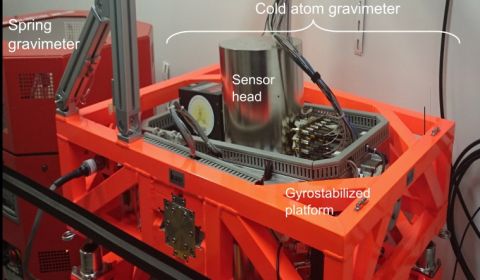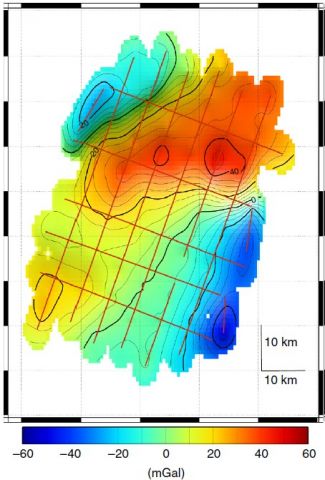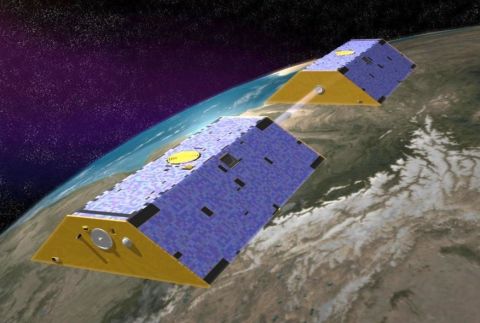Contact : Yannick Bidel (yannick.bidel@onera.fr)
Inertial sensors with atom interferometry
Marine and airborne gravimeter
| GIRAFE Gravimeter installed in the oceanographic vessel Beautemps-Beaupré of SHOM (French Navy) | Gravity map in the Meriadzec area (North Atlantic) obtained with GIRAFE |
ONERA has been developing a quantum sensor (GIRAFE) capable of performing gravity measurements from a boat or an airplane for about fifteen years. This technology has revolutionized the field because it is the only one able to provide absolute gravity measurements from a mobile carrier and thus avoids calibration and drift estimation procedures that can lead to measurement errors and increase the cost and duration of a gravity campaign. Today this technology is mature with marine and airborne demonstrations with accuracies equal or better than classical gravimeters [1] [2].
This quantum gravimeter is currently being industrialized with the company iXblue to equip the French Navy with quantum gravimeters. ONERA is also preparing the second generation of on-board quantum gravimeters. The goal is to reduce the weight and volume of the instrument in order to access smaller carriers such as drones, but also to improve accuracy in order to access temporal variations in gravity with important applications in geophysics (earthquakes, volcanoes, ice melting ...).
[1] Y. Bidel et al., Absolute marine gravimetry with matter-wave interferometry, Nature Communications, vol. 9, p. 627, 2018.
[2] Y. Bidel et al., Absolute airborne gravimetry with a cold atom sensor, Journal of Geodesy, vol. 94, n° 2, p. 20, 2020.
Gravity measurements from space
| GRACE satellites (NASA, DLR) equipped with electrostatic accelerometers from ONERA |
The measurement of the gravity field from space is carried out with satellites equipped with ultrasensitive accelerometers. Currently, the various space missions (CHAMP, GOCE, GRACE, GRACE FO) use electrostatic accelerometers made by ONERA. For the future, ONERA is studying the possibility of associating a quantum accelerometer with the electrostatic accelerometer in order to improve the long-term stability. Experimental and theoretical studies of the hybridization between an electrostatic and a quantum accelerometer are in progress in order to validate the concept [3] [4].
[3] P. Abrykosov et al., Impact of a novel hybrid accelerometer on satellite gravimetry performance, Advances in Space Research, vol. 63, n° 10, p. 3235 3248, 2019.
[4] N. Zahzam et al., Hybrid Electrostatic–Atomic Accelerometer for Future Space Gravity Missions, Remote Sensing, vol. 14, n° 14, Art. no 14, janv. 2022.
Multi-species atom interferometry
In order to improve the performance of inertial sensors based on atom interferometry, ONERA is developing a sensor that simultaneously handles several atomic species [5]. A proof-of-concept experiment with two isotopes of rubidium and one isotope of cesium is currently underway.
[5] A. Bonnin et al., New concepts of inertial measurements with multi-species atom interferometry, Applied Physics B, vol. 124, n° 9, p. 181, 2018.
Inertial measurement units
An inertial measurement unit is an instrument composed of three accelerometers and three gyrometers that allows positioning in the absence of or in addition to the GNSS (Global Navigation Satellite System).
ONERA is developing a hybrid conventional/quantum inertial measurement unit. The idea is to improve the long-term stability of a classical inertial measurement unit and thus the positioning accuracy by periodically calibrating the classical sensors with inertial measurements from quantum sensors. A proof-of-concept experiment is under development. Quantum measurements of accelerations along the vertical and horizontal axis have already been demonstrated to calibrate classical accelerometers [6] [7]. We are now working on rotation measurements.
[6] I. Perrin et al., Zero-velocity atom interferometry using a retroreflected frequency-chirped laser, Physical Review A, vol. 100, nᵒ 5, p. 053618, 2019
[7] J. Bernard et al., Atom interferometry using σ+ σ- Raman transitions between F = 1 mF = -1 and F = 2, mF= 1, Phys. Rev. A, vol. 105, n° 3, p. 033318, mars 2022.
Electromagnetic sensors with Rydberg atoms
ONERA is developing an electromagnetic field sensor based on Rydberg atoms. The originality of our approach is to use cold Rydberg atoms trapped in optical tweezers in order to increase the sensitivity, the spatial resolution and/or the frequency resolution. Our approach should also allow the use of quantum metrology techniques using entangled states to improve the accuracy of the measurement. A proof-of-concept experiment is under construction.



